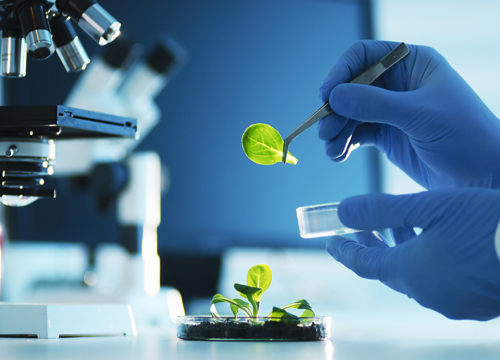From X to Food Featured Signal of Change: SoC1244 July 2021

Many start‑ups and university research labs have been developing methods for using bioengineered microbes to convert nutrients into food. Technologies already allow for such processes to yield specific proteins that can find cost-effective use in animal feed, synthetic meat, artificial-dairy products, and more. But existing production processes have tended to rely on conventional agriculture to produce the nutrients that microorganisms convert into proteins or other food products. New methods have been emerging that can produce food without requiring such inputs. Biotechnologies may eventually become able to transform virtually any kind of input into food, reducing or even eliminating humanity's dependence on conventional agriculture.
Natural gas is not the only nonagricultural feedstock that new food-production methods can use.
Unibio (Unibio International; London, England) is one of several companies that have been commercializing technology for transforming natural gas into food proteins by way of engineered microbes. In April 2021, Unibio signed an agreement with Gulf Biotech (Al Hidd, Bahrain) to construct a protein plant in Qatar. Unibio already has an operational gas‑to-protein plant in Russia and plans to construct another in Saudi Arabia. Other gas‑to-protein start‑ups, such as Calysta (Menlo Park, California), are working to establish a worldwide network of gas‑to-protein manufacturing facilities and have received substantial investments from venture-capital and fossil-fuel companies. Currently, such start‑ups are focusing on producing protein for animal feed—a goal that fits well with the limitations of current technology. But eventually, the gas‑to-protein technologies should become able to produce proteins for incorporation into a wide variety of food products for human consumption.
Natural gas is not the only nonagricultural feedstock that new food-production methods can use. University researchers have been working on methods for converting hydrogen into proteins in processes that not only can capture carbon dioxide from the atmosphere but also can use hydrogen that saw production through solar-powered electrolysis or through other renewable-energy methods. Other research teams have developed methods for using engineered microbes to convert various kinds of waste into edible protein directly. For example, the US Department of Defense's (Arlington County, Virginia) DARPA (Defense Advanced Research Projects Agency; Arlington, Virginia) is funding various universities' efforts to devise a system for producing food proteins from plastic and paper waste. Notably, some existing synthetic-protein-production processes already do produce food from waste indirectly. For example, String Bio (Bengaluru, India) produces animal‑feed proteins from methane that comes from natural‑gas wells and landfills. Continued technology advancement could yield industrial processes that use engineered organisms to convert a wide variety of nonagricultural inputs into food.
The new technologies that transform nonagricultural feedstocks into protein are not emerging in isolation but as part of an ecosystem of rapidly developing technologies that have a wide variety of commercially beneficial uses in areas such as pharmaceuticals development, health care, and cosmetics manufacturing. For decades, these technologies have been enabling scientists to modify microorganisms to produce specific biomolecules; however, until very recently, the relevant technologies were too costly to find use in food applications (in which industrial agriculture has already made protein costs extremely low). Existing gas‑to-protein start‑ups have been targeting animal-feed protein initially, likely because current limitations in synthetic biology and precision-fermentation technologies make it difficult to produce protein mixes that have a taste, smell, texture, and complexity that humans find palatable (for similar reasons, current synthetic‑meat products typically comprise proteins that derive from plant-based sources and use microbe-generated proteins as additives). In time, however, technologies should advance enough to become capable of transforming nonagricultural inputs into ever‑larger proportions of the protein‑and-nutrient mix that makes up synthetic foods, perhaps ultimately reaching 100% of that mix. These advances, in combination with parallel advances in technologies such as 3D bioprinting and cultured meat, may enable the complete decoupling of food production from agriculture. In this scenario, specialized bioreactors that use only water, air, and energy would create virtually any kind of food directly.
A world in which humans can manufacture all the food they need without farming or fishing would look dramatically different from today's world—in both positive and negative ways. For example, food production could localize within cities or even within individual homes and business locations, substantially lowering the monetary and environmental costs of transporting food long distances. The enormous environmental devastation and global-warming intensification that results from agriculture could disappear, opening up vast portions of Earth's surface for rewilding efforts that are vital for offsetting carbon pollution. The world could avoid suffering from the food-production crises that can result from the combined effects of global warming, environmental degradation of arable land, depletion of fisheries, and increases in global consumption of meat. But urbanization could accelerate, and populations that depend on farming for their livelihoods could face economic devastation. Many countries are already struggling with political problems that stem from the increasing urban‑rural divide, and these problems could intensify.
No guarantee exists that any of these changes will occur. Enormous uncertainty still surrounds whether, when, and to what extent technologies that can transform nonagricultural inputs into food will become capable of disrupting conventional agriculture. Many nontechnological obstacles to widespread commercialization exist, including regulatory protectionism that could favor the powerful interests of existing agricultural players, reluctance among consumers to accept synthetic foods, and novel issues concerning the safety and environmental impacts of synthetic foods. Such obstacles could delay adoption but likely not prevent it permanently, assuming synthetic‑food technology can deliver on its promise to create cleaner, cheaper, and better-quality food products that are much less harmful to the environment. Ultimately, then, whether x‑to‑food technology prevails in the market might come down to a very straightforward factor: Can the technology work?